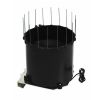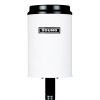HOBO Pendant Event Data Logger
Features
- Records tips or momentary contact closures and temperature
- Event-based data storage provides detailed data and efficient memory usage
- Stores over 16,000 tips (160 in. of rainfall with a 0.01 in. rain gauge)
- Expedited repair and warranty service
- Lifetime technical support
- More
Overview
The Onset HOBO Pendant Event Data Logger accurately measures rainfall. The event logger determines rainfall rates, times, and duration after deployment with most standard tipping-bucket rain gauges. Efficiently gather and store momentary contact events and temperature data.
Event Data
Gain access to detailed event data with the Onset HOBO Pendant Event Data Logger accurately measures rainfall. The event logger determines rainfall rates and time. Event data is only stored when it happens for better memory usage. Use a solar radiation shield for accurate temperature measurement in sunlight applications. See RS1 Solar Radiation Shield (assembly required) and M-RSA (pre-assembled) Solar Radiation Shield.
External Event Input
Event sensor: Two-wire interface suitable for measuring mechanical and electrical contact closures
Maximum input frequency: 1 Hz (1 pulse per second)
Lockout time: 500 ms
Minimum pulse width: 1 ms (hardware debounce)
Input/output impedance: 100 kΩ
Edge detection: Falling edge, contact closure, or Schmitt-trigger buffer
Preferred switch type: Normally open. For maximum battery life, the event input should be used with its preferred switch type. The logger will work with normally closed switches, but battery life will be compromised.
Open circuit input voltage: Battery voltage; nominally 3.0 V
Maximum input voltage: Battery voltage + 0.3 V
User connection: 24 AWG, 2 leads: white (+), black (-)
Temperature Measurement
Measurement range: -20° to 70°C (-4° to 158°F)
Accuracy: ± 0.53°C from 0° to 50°C (± 0.95°F from 32° to 122°F), see Plot A. A solar radiation shield is required for accurate temperature measurements in sunlight.
Resolution: 0.14°C at 25°C (0.25°F at 77°F), see Plot A
Drift: Less than 0.1°C/year (0.2°F/year)
Response time: Airflow of 2 m/s (4.4 mph): 10 minutes, typical to 90%
Logger
Time accuracy: ± 1 minute per month at 25°C (77°F), see Plot B
Operating range: -20° to 70°C (-4° to 158°F)
Environmental rating: Tested to NEMA 6 and IP67; suitable for deployment outdoors
Drop specification: 1.5 m (5 ft) onto concrete
NIST traceable certification: Available for temperature only at additional charge; temperature range -20° to 70°C (-4° to 158°F)
Battery: CR-2032 3V lithium battery; 1 year typical use
Memory: 64K bytes
Materials: Polypropylene case; stainless steel screws; Buna-N o-ring; PVC cable insulation
Weight: 50 g (1.7 oz.)
Dimensions: 71 x 33 x 23 mm (2.8 x 1.3 x 0.9 inches); 1.8 m (6 ft) cable
- HOBO Pendant Event Data Logger
- Tie wraps
- Adhesive mount
In The News
Wildfire Prevention in the Sierra Nevada Region with the Yuba Watershed Institute
Though recent wildfires have sparked new conversations about wildfire management and response, groups like the Yuba Watershed Institute have been monitoring the forests and water resources of the Sierra Nevada region for decades, managing approximately 5,000 acres of land with the Bureau of Land Management (BLM) and about 7,000 acres in private land partnerships. The goal of the Institute is to work with local communities and land agencies to improve watershed and forestry management through informed practices and public outreach. The goals of the Yuba Watershed Institute are three-fold: Improve the ability of fire suppression agencies like the California Department of Forestry and Fire Protection ( CAL FIRE ) and the US Forest Service.
Read MoreWave Sensors Integration with NexSens Buoys: A Cutting-Edge Solution for Wave Measurment
Real-time wave data supports accurate weather prediction, safe and efficient maritime operations, and provides valuable safety and operating condition information for recreation and commercial fishing. Understanding wave dynamics also helps with the design of protective coastal structures like seawalls, breakwaters, and jetties. It also supports better prediction of their impact on sediment transport and coastal geomorphology. Wave data is a key factor in qualifying and designing offshore wind farms and harnessing kinetic energy for electrical generation. It helps with the understanding of ocean-atmosphere interactions and contributes to studies of sea-level rise and climate change impacts.
Read MoreSpring 2025 Environmental Monitor Available Now
In the Spring 2025 edition of the Environmental Monitor, we highlight partnerships across the world and the importance of collaboration between government agencies, universities, environmental groups, local communities, and other stakeholders. From great white shark research in Cape Cod to monitoring fisheries in Lake Erie, this latest edition underscores partnerships that connect stakeholders in a watershed through environmental data. With an emphasis on data sharing, a combination of real-time and discrete sampling keeps the public and partners informed of environmental conditions. Our writers also sought out science professionals dedicated to working with peers within and outside of the environmental sector.
Read More
















